How to grow gatsania (gazania) from seeds?

Gatsania is an exotic plant that can ennoble any area. But like other exotics, it requires very careful handling and thoughtful approach. It's time to figure out how to grow this plant from seeds in Russian conditions.
What seeds look like
To begin with, it is worth clarifying that gatsania and gazania are synonyms only in everyday speech. From the point of view of biologists, gazania is one of the genera in the Asteraceae plant family. Gatsania harsh is only one of the species in this genus. Therefore, it is important not to confuse such crops, otherwise there is a great risk of buying planting material that is not adapted to Russian conditions. Gatsania seeds are medium-sized achenes, covered with hairs and having a "crest" of light gray color.
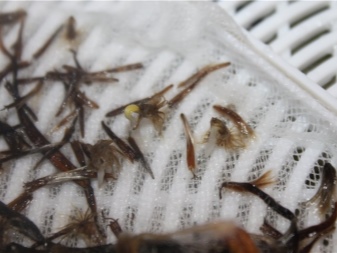

Optimal sowing time
Planting gatsania seeds should take place as early as possible. In the southern regions of the country, the end of February is suitable for this procedure. In more northern regions, you need to wait until the first decade of March. In any case, the guideline will be the sufficiency of sunlight and the absence of the need to highlight the seedlings. With this approach, replanting in open land can be planned at the end of May, but there are times when the dates have to be shifted.
If it is decided to grow gazania flowers immediately in the open field, then there is nothing impossible in this. But such a procedure is acceptable only in areas with a warm climate. Moreover, you will have to wait 45-60 days after the usual date of disembarkation for seedlings. Only in April or even at the beginning of May, daylight hours and air temperature steadily reach the desired values. Of course, regardless of the specific sowing time, you need to take care of the preparation of the soil.
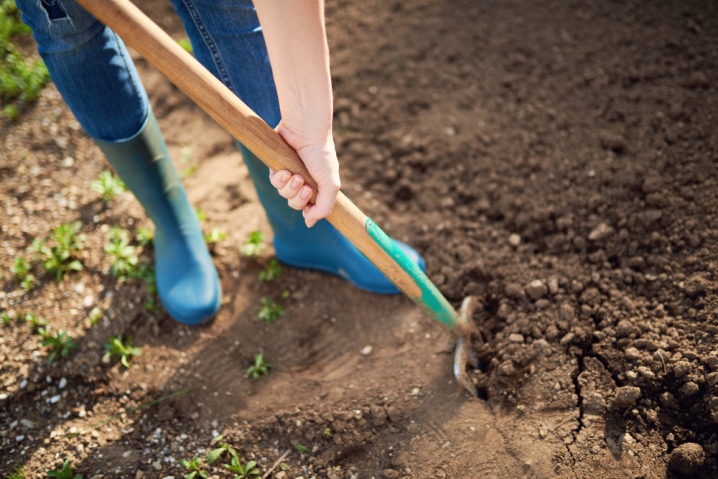
Seed collection
The gatsania seeds themselves are quite large and can be easily picked by hand. But there are a number of subtleties and nuances that must be taken into account. Ripening of seeds takes approximately 60 days. So that they do not scatter unpredictably, experts advise covering the seed capsule with gauze on all sides.
Important: if the gardener received the seeds, they must be planted within 2 years - otherwise, germination will be lost.
It should be borne in mind that gatsania seeds may not have time to ripen over the summer. They are finally ready only when the hot and dry weather is until October. In addition, in hybrid varieties, the safety of varietal traits when breeding with seeds cannot be ensured. They show the characteristics of the original plants used for hybridization. But some gardeners are not afraid of this problem, especially since any gating looks attractive.
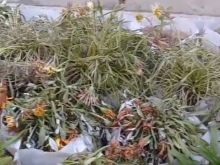

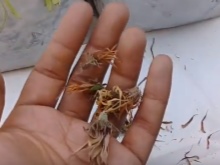
How to plant and grow seedlings
Growing gatsania seedlings at home is possible only in containers of great depth. Once the seeds have hatched, a long root will begin to form. And if it bends or breaks in a pot, there can be serious problems.
The container will have to be covered with a transparent lid. For this purpose, both plastic and glass or polycarbonate covers can be used. But you can do it easier by using cellophane, plastic cling film.
Be sure to take care of draining the container. Otherwise, the sown plants can simply rot.
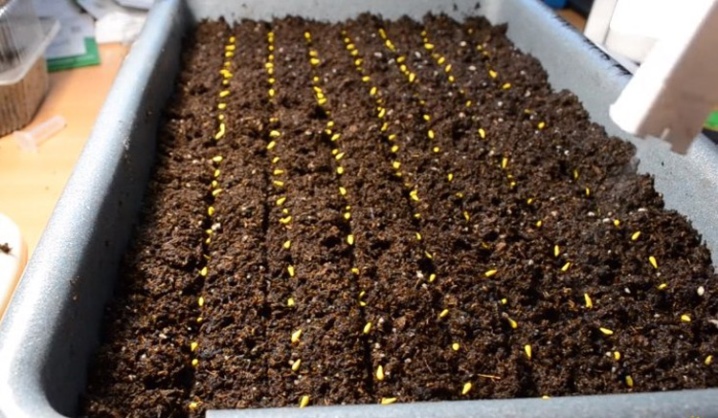
Sowing gatsaniya is necessary in the soil with a light structure.At the same time, it is desirable to provide maximum nutritional value. It is recommended to take soil from an ordinary garden flower bed. To improve its characteristics, it is worth steaming the soil in a water bath or boiling it in an oven for at least 20 minutes. After that, vermiculite and wood ash are added. The role of ash is to prevent fungal infection. It is important to know another trick: vermiculite can be replaced with coarse sand.
Sowing gatsania seeds is facilitated by their large size. Several grooves are prepared on the soil surface. Their depth should be very shallow, since such strips are intended only for planning seeding. Seeds are laid out with an interval of 20 mm between themselves. The row spacing is 30 mm.
Sprinkle the seed a little with a sandy soil mixture. The thickness of its layer should not exceed a centimeter. The immediately filled material is sprayed using clean water. A diluted growth accelerator can be used instead.
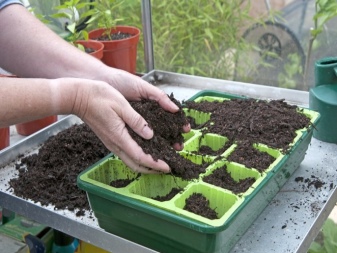
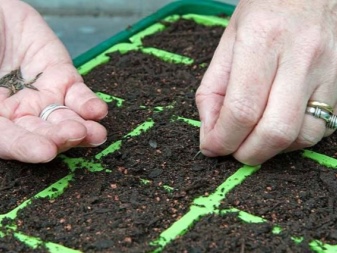
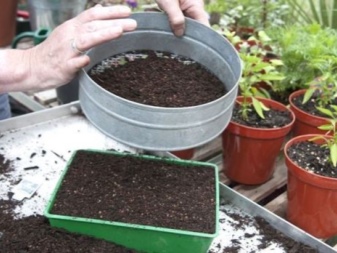
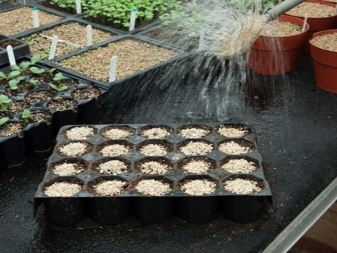
Sometimes the ground is covered with snow. You can even take it from the freezer if the weather is warm outside. When the snow melts in the room, the most natural stratification will occur, and even combined with watering.
Germinating seeds under a cover requires an air temperature of +18 to +20 degrees. It is better to place the container on a lighted windowsill. Every day, the lid is slightly raised for a short while, airing the container.
If condensation forms, it must be wiped off. Complete drying out of the soil is unacceptable, as well as excessive moisture. Therefore, the best irrigation method is to use a spray bottle.
Compliance with these conditions allows you to wait for seed germination on average for 10-11 days.
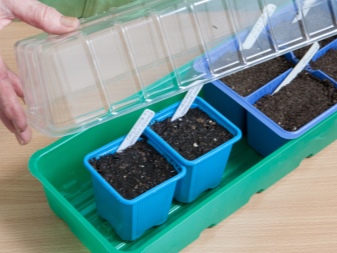

A good alternative is to use peat pots, that is, special pills. Pills purchased or made by hand are placed in the tray. Important: the tray must be deep. Put 1 seed in the middle of the tablet. Then it is germinated in a makeshift greenhouse as described above. The advantage of peat tablets is that diving is possible without damaging the roots and other parts of the plant.
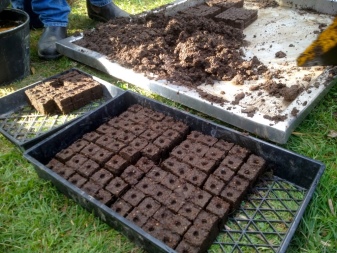
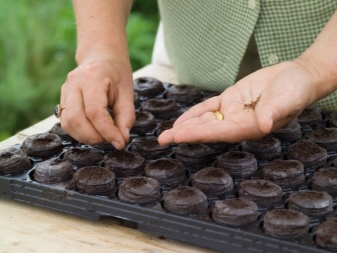
Sometimes the planting of gatsania is unnecessarily thick. In this case, the seedlings will certainly dive. In especially difficult cases, the procedure is carried out starting from the 15th day of development. But at every opportunity, experts advise to wait for the appearance of one true leaf (or better, two). It is recommended to dive seedlings into deep yogurt trays or disposable glasses with a volume of 0.5 liters.
but even better for picking use the same peat pots... They are very beneficial for the grown plants and in addition do not harm the environment. Before transplanting, the seedlings must be thoroughly watered. The sprouts are moved by the transfer method. In the new container, the missing soil is added, everything is watered again and the seedlings are sent to harden (ideally, on a glazed loggia, where the temperature is maintained not lower than +12 and not higher than +15 degrees).
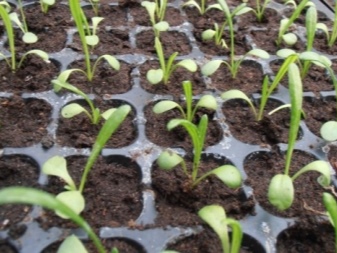
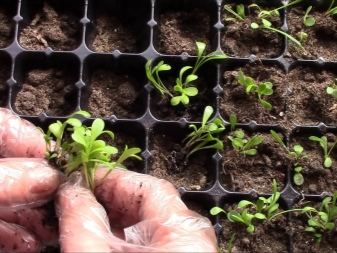
During the cultivation of seedlings, it is necessary to maintain the temperature from +23 to +26 degrees. As soon as real leaves appear, you can reduce this indicator to +20 degrees in the daytime and to + 16-18 degrees in the dark.
Some types of gatsania can only be grown by cuttings.
It is better if the soil has neutral acidity (deviation towards alkalinity or acidity is unacceptable).
In order for the seedlings to develop normally, they need a backlight for at least 12 hours every day. Otherwise, the plants will start to stretch. Phytolamps or daylight lamps help to compensate for the lack of light. You need to use them in the morning and evening. Typically 4 hours of additional lighting is sufficient.
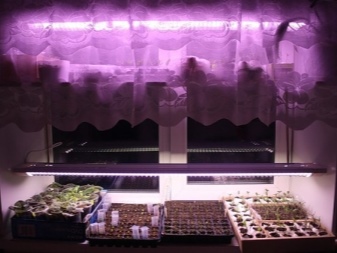
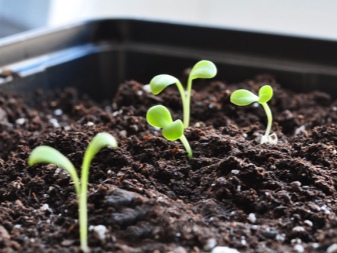
As for grafting, the difficulty with this technique is due to the long wait for flowering. Sometimes it does not have time to happen before the cold weather. But still they use cuttings. And not only in relation to certain rare species.This procedure is also useful when it is planned to grow seedlings indoors.
A healthy and well-developed lateral shoot is needed for cuttings.
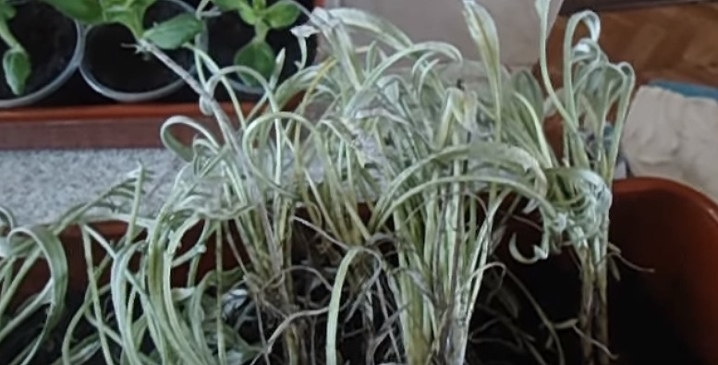
The incision is made obliquely with a sharp knife. The lower foliage must be removed. It is better if the shoot has a "heel" (this is the name of the thickened area at the very base). Prepared cuttings are treated with growth stimulants of their choice.
Instead of them, folk remedies are sometimes used, such as:
honey;
aloe vera juice;
aqueous yeast solution.
Cuttings prepared in this way are buried in the ground in a greenhouse. It must be properly moistened and disinfected. Rooting can be expected if the temperature is maintained at +18 degrees and humidity is at least 60%. Airing and rational limitation of watering helps to avoid rotting cuttings.
It is very important to water the seedlings with an unsaturated solution of potassium permanganate or initially put ash in the ground.


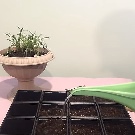
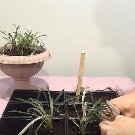
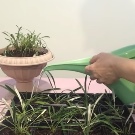

Gatsania seeds are sometimes sown directly into the ground at the permanent planting site. To select the best seedlings, several seeds are placed in the holes. However, this technique is acceptable only in the spring months, when the frost ends. And even then, in the southern regions, only early plant varieties can be grafted.
Calcining the soil before planting ideally takes about 3 hours. Important: a high temperature must be maintained at this moment. Before cooling the soil, a saturated solution of potassium permanganate is added there. Three-hour soaking in hydrogen peroxide helps to accelerate seed germination. When shoots are formed, the container is moved to a place where there are no drafts.
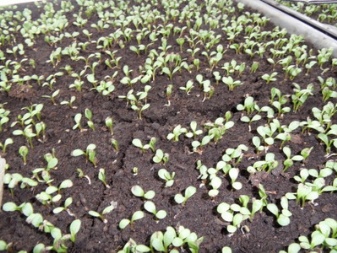

Landing in open ground
Ripe gatsania bushes reach a height of about 0.3 m.Therefore, planting them between higher crops means losing sight of the plants and losing their characteristic decorative advantage. Moreover, for the culture itself, the lack of light is not at all good. It should be remembered that the bushes will grow 0.25 m wide.
The optimal time for transplanting into open ground is the end of May and the first days of June.
In the southern regions of Russia, you can take a chance and carry out this procedure from April 14 to 30. Important: at night during the transplant, there should be at least +10 degrees. We must not forget about the requirements for the lighting of the site. They are too often ignored by gardeners - as a result of gating, they stop blooming.
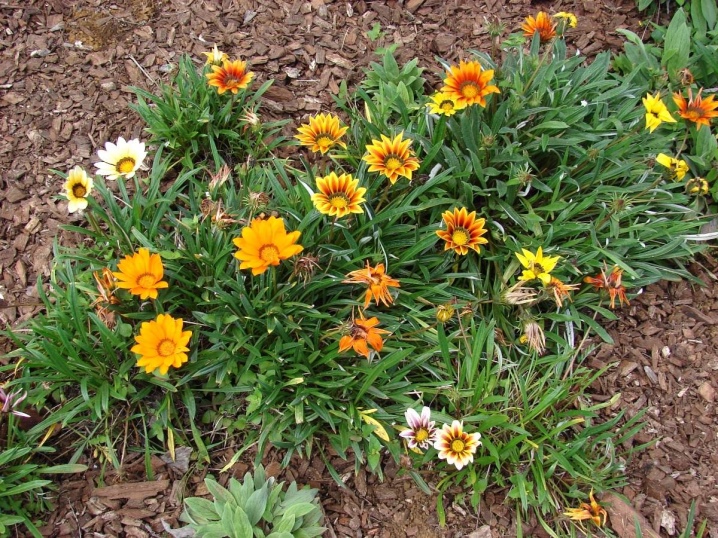
It is necessary to select areas with nutritious soil. In this case, the drainage of open plantings is no less important than in a pot. Tropical beauty will quickly perish if it ends up in a puddle. The flower beds are saturated with mineral compositions or humus, and after planting, they are thoroughly mulched.
Gatsania can also be grown in a yard flowerpot. But its bottom must have holes for water drainage. It is better to put large stones on top. Replacing them with foam is not entirely equivalent. Important: to grow this crop, it is worth saturating the ground with peat - it will let water through without waterlogging. This property of peat is very helpful, given the deliberately unplanned precipitation in summer.
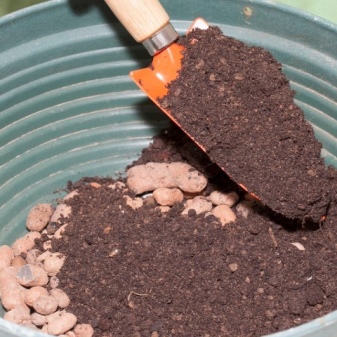
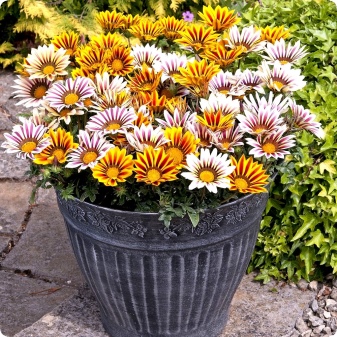
The size of the planting holes must exactly match the dimensions of the pots. It is necessary to transplant plants there with a clod of earth. When using a peat tablet, it is transferred whole. It is advisable to cut the disposable cups in order to facilitate the extraction of the roots.
Gatsaniya can only be planted in a dug up fertilized area. On it, recesses are made with a depth of 0.15-0.2 m.A gap of 0.25-0.3 m is left between the holes. The exact indicator depends on the specific variety. Planting too close interferes with the normal development of plants.
The seedlings will have to be hardened. Water it when there is 1 or 2 days left before transplanting. All plants are carefully rolled into holes. It is necessary to ensure that there are no voids, and that soil gets into them. Further, the earth is carefully tamped and watered.
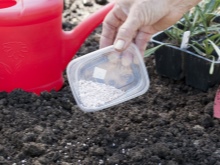
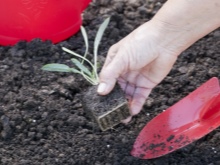
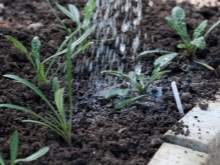
Correct care
Whether it will be possible to grow gatsania depends not only on planting, but also on leaving.Despite the African origin of this culture, it definitely needs watering on hot days. Top dressing is added monthly to the water (if necessary, of course). The optimal nutritional composition is a standard set of minerals for flowering plants. You can buy it at any store.
It is advised to combine weeding of flower beds with loosening the earth. Such manipulations are carried out after heavy rains or powerful irrigation. If the earth crust is allowed to cake, the gatsania roots will suffer from lack of air.
In the absence of precipitation, the culture is watered not 2 or 3 times a month, as usual, but daily.
Withered inflorescences should be systematically trimmed.

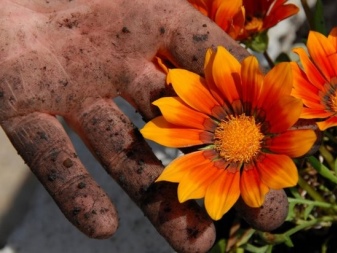
Poor and depleted lands do not allow counting on the beautiful bloom of gatsania. In such areas, as well as on rocky strips, it is advised to feed the crop every 15–20 days. In normal flower beds, where fertile soil was laid, top dressing is carried out every 30-40 days. For 1 sq. m. lay an average of 25 g of mineral composition. More precisely, the amount can be selected only taking into account the state of specific plants and the land around them.
Preparing gats for winter is easy. It is dug up and transplanted into flower pots. Keep these pots in the house. Then the culture will please with its appearance even in the autumn months. But this must be done correctly and thoughtfully.
The plant needs warmth - at least +10 degrees. He needs as much light as possible. Even if flowering is interrupted, the backlight is not weakened until spring. But feeding is contraindicated. At the same time, loosening of the watered earth and protection from drafts are mandatory.
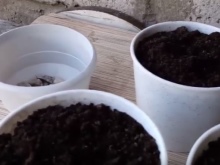

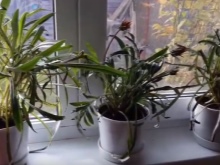
Diseases and pests
If heavy prolonged rains come, gatsaniya suffers from waterlogging. A weakened plant can get sick with gray mold.
Thorough drainage almost always helps to prevent damage from this ailment. If the plant is completely infected with gray mold, it will not be cured. The patient gatsaniya dispose of. In addition to rational watering, periodic spraying with "Fitosporin" helps prevent gray mold damage.
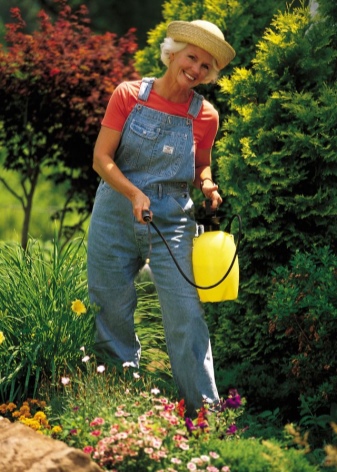

The plant can be affected by aphids, spider mites, snails and slugs. Snails, if they have already crawled, are collected by hand or using special traps. Caught insects are burned or fed to chickens.
To avoid attacks of ticks, snails and slugs helps to sprinkle row-spacing and near-trunk circle with slaked lime. In this case, you will also have to weed the ground in a timely manner, since weeds turn out to be the "support base" of pests. To combat aphids, in addition to the well-known "Aktara", use "Fitoverm" or "Biotlin". Suppression of spider mites is achieved with the help of "Fufanon" or "Ditoks".
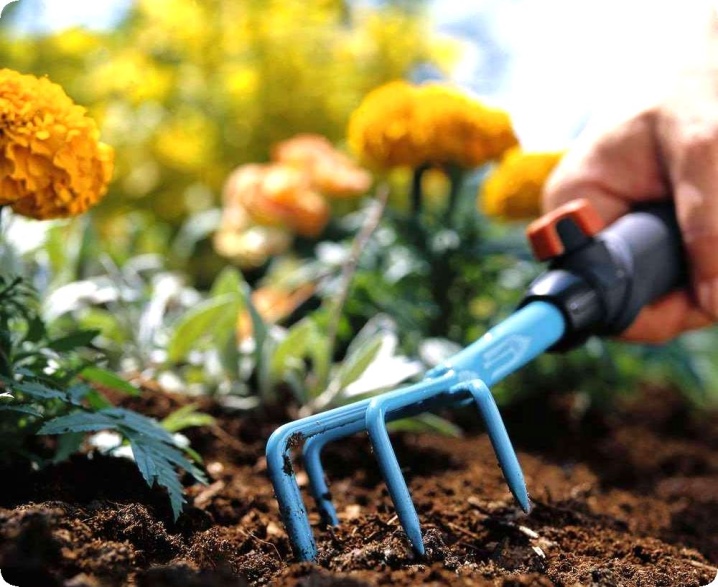
See the video about growing gatsania (gazania) from seeds and caring for it.


































































































The comment was sent successfully.